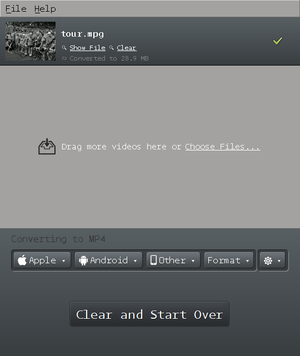Difference between revisions of "Web video"
| Line 1: | Line 1: | ||
[[Category:tutorial]] | [[Category:tutorial]] | ||
== video codecs and containers explained== | == video codecs and containers explained== | ||
Video | Video file formats (.avi .mp4 .ogv .mkv) are containers to video and audio streams | ||
* Each '''video format''' allow specific audio and video codecs | |||
* '''codecs''' are the way by which a audio or video stream is encoded and decoded. | |||
''' | |||
Current web browsers support: | |||
* video format: '''.mp4''' with streams | |||
** '''video''' encoded with '''H264 codec''' | |||
** '''audio''' encodec with '''AAC''' (multichannel) or '''MP3''' (stereo) codecs | |||
==prepare your files== | ==prepare your files== | ||
To be certain that your videos will play in all current browsers, you'll need to have your videos or audio encoded in the codecs above. | |||
There are several solutions to do this | There are several solutions to do this: | ||
* [https://handbrake.fr/ Handbrake] | |||
* [http://www.mirovideoconverter.com/ Miro] | |||
===in Miro=== | ===in Miro=== | ||
| Line 76: | Line 30: | ||
[[File:Miro Video Converter_005.png|300px]] | [[File:Miro Video Converter_005.png|300px]] | ||
===in Handbrake=== | |||
See https://www.techspot.com/article/1131-hevc-h256-enconding-playback/ | |||
== video tag == | == video tag == | ||
| Line 81: | Line 38: | ||
<video controls> | <video controls> | ||
<source src="http://publicationstation.wdka.hro.nl/go-student/Andre-Castro/videos/tour.mp4" type="video/mp4"> | <source src="http://publicationstation.wdka.hro.nl/go-student/Andre-Castro/videos/tour.mp4" type="video/mp4"> | ||
</video> | </video> | ||
</source> | </source> | ||
| Line 87: | Line 43: | ||
This is the simplest a web video player you can get. | This is the simplest a web video player you can get. | ||
A <nowiki><video></nowiki> tag encapsulating | A <nowiki><video></nowiki> tag encapsulating a <nowiki><source></nowiki> tag with the file content of the video | ||
The argument <nowiki>controls</nowiki> make sure the video players has controls. | The argument <nowiki>controls</nowiki> make sure the video players has controls. | ||
| Line 97: | Line 53: | ||
<audio controls> | <audio controls> | ||
<source src="https://ia802608.us.archive.org/15/items/OTRR_X_Minus_One_Singles/XMinusOne55-04-24001NoContact.mp3" type="audio/mp3"> | <source src="https://ia802608.us.archive.org/15/items/OTRR_X_Minus_One_Singles/XMinusOne55-04-24001NoContact.mp3" type="audio/mp3"> | ||
</audio> | |||
</audio> | |||
</source> | </source> | ||
| Line 114: | Line 69: | ||
<video controls loop width=800 poster="http://static.ddmcdn.com/gif/tour-de-france-top-ways-the-race-has-changed-picnic-130619.jpg"> | <video controls loop width=800 poster="http://static.ddmcdn.com/gif/tour-de-france-top-ways-the-race-has-changed-picnic-130619.jpg"> | ||
<source src="http://publicationstation.wdka.hro.nl/go-student/Andre-Castro/videos/tour.mp4" type="video/mp4"> | <source src="http://publicationstation.wdka.hro.nl/go-student/Andre-Castro/videos/tour.mp4" type="video/mp4"> | ||
</video> | </video> | ||
</source> | </source> | ||
Latest revision as of 12:09, 27 November 2018
video codecs and containers explained
Video file formats (.avi .mp4 .ogv .mkv) are containers to video and audio streams
- Each video format allow specific audio and video codecs
- codecs are the way by which a audio or video stream is encoded and decoded.
Current web browsers support:
- video format: .mp4 with streams
- video encoded with H264 codec
- audio encodec with AAC (multichannel) or MP3 (stereo) codecs
prepare your files
To be certain that your videos will play in all current browsers, you'll need to have your videos or audio encoded in the codecs above.
There are several solutions to do this:
in Miro
- Select the file you want to convert to .ogv and .mp4
- Choose the Format menu:
- For a .mp4 video Video >
MP4 - For a .ogv video Video >
Ogg Theora
- For a .mp4 video Video >
- Press the large button: "Convert to ..."
Conversion will start. When it is done the new file will be saved.
in Handbrake
See https://www.techspot.com/article/1131-hevc-h256-enconding-playback/
video tag
<video controls>
<source src="http://publicationstation.wdka.hro.nl/go-student/Andre-Castro/videos/tour.mp4" type="video/mp4">
</video>
This is the simplest a web video player you can get.
A <video> tag encapsulating a <source> tag with the file content of the video
The argument controls make sure the video players has controls.
audio tag
If you want to create an audio player, it is similar to video:
<audio controls>
<source src="https://ia802608.us.archive.org/15/items/OTRR_X_Minus_One_Singles/XMinusOne55-04-24001NoContact.mp3" type="audio/mp3">
</audio>
video / audio tag attributes
Besides controls the <video> has a number of other attributes.[1]
- controls - if present, show player's controls
- autoplay - if present, automatically start player as page loads.
- loop - if present,
- poster - presents a poster image while the video is stopped as
- height
- width
<video controls loop width=800 poster="http://static.ddmcdn.com/gif/tour-de-france-top-ways-the-race-has-changed-picnic-130619.jpg">
<source src="http://publicationstation.wdka.hro.nl/go-student/Andre-Castro/videos/tour.mp4" type="video/mp4">
</video>
notes
- ↑ Read more on video attributes in https://developer.mozilla.org/en-US/docs/Web/HTML/Element/video
